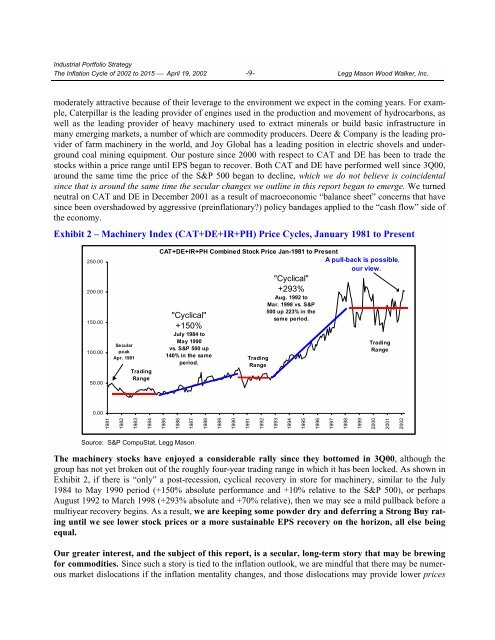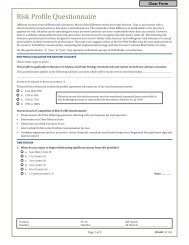The Inflation Cycle of 2002 to 2015 - Uhlmann Price Securities
The Inflation Cycle of 2002 to 2015 - Uhlmann Price Securities
The Inflation Cycle of 2002 to 2015 - Uhlmann Price Securities
Create successful ePaper yourself
Turn your PDF publications into a flip-book with our unique Google optimized e-Paper software.
Industrial Portfolio Strategy<br />
<strong>The</strong> <strong>Inflation</strong> <strong>Cycle</strong> <strong>of</strong> <strong>2002</strong> <strong>to</strong> <strong>2015</strong> ⎯ April 19, <strong>2002</strong> -9- Legg Mason Wood Walker, Inc.<br />
moderately attractive because <strong>of</strong> their leverage <strong>to</strong> the environment we expect in the coming years. For example,<br />
Caterpillar is the leading provider <strong>of</strong> engines used in the production and movement <strong>of</strong> hydrocarbons, as<br />
well as the leading provider <strong>of</strong> heavy machinery used <strong>to</strong> extract minerals or build basic infrastructure in<br />
many emerging markets, a number <strong>of</strong> which are commodity producers. Deere & Company is the leading provider<br />
<strong>of</strong> farm machinery in the world, and Joy Global has a leading position in electric shovels and underground<br />
coal mining equipment. Our posture since 2000 with respect <strong>to</strong> CAT and DE has been <strong>to</strong> trade the<br />
s<strong>to</strong>cks within a price range until EPS began <strong>to</strong> recover. Both CAT and DE have performed well since 3Q00,<br />
around the same time the price <strong>of</strong> the S&P 500 began <strong>to</strong> decline, which we do not believe is coincidental<br />
since that is around the same time the secular changes we outline in this report began <strong>to</strong> emerge. We turned<br />
neutral on CAT and DE in December 2001 as a result <strong>of</strong> macroeconomic “balance sheet” concerns that have<br />
since been overshadowed by aggressive (preinflationary?) policy bandages applied <strong>to</strong> the “cash flow” side <strong>of</strong><br />
the economy.<br />
Exhibit 2 – Machinery Index (CAT+DE+IR+PH) <strong>Price</strong> <strong>Cycle</strong>s, January 1981 <strong>to</strong> Present<br />
250.00<br />
200.00<br />
150.00<br />
100.00<br />
50.00<br />
Secular<br />
peak<br />
Apr. 1981<br />
Trading<br />
Range<br />
CAT+DE+IR+PH Combined S<strong>to</strong>ck <strong>Price</strong> Jan-1981 <strong>to</strong> Present<br />
A pull-back is possible,<br />
our view.<br />
"Cyclical"<br />
+150%<br />
July 1984 <strong>to</strong><br />
May 1990<br />
vs. S&P 500 up<br />
140% in the same<br />
period.<br />
Trading<br />
Range<br />
"Cyclical"<br />
+293%<br />
Aug. 1992 <strong>to</strong><br />
Mar. 1998 vs. S&P<br />
500 up 223% in the<br />
same period.<br />
Trading<br />
Range<br />
0.00<br />
1981<br />
1982<br />
1983<br />
1984<br />
1985<br />
1986<br />
1987<br />
1988<br />
1989<br />
1990<br />
1991<br />
1992<br />
1993<br />
1994<br />
1995<br />
1996<br />
1997<br />
1998<br />
1999<br />
2000<br />
2001<br />
<strong>2002</strong><br />
Source: S&P CompuStat, Legg Mason<br />
<strong>The</strong> machinery s<strong>to</strong>cks have enjoyed a considerable rally since they bot<strong>to</strong>med in 3Q00, although the<br />
group has not yet broken out <strong>of</strong> the roughly four-year trading range in which it has been locked. As shown in<br />
Exhibit 2, if there is “only” a post-recession, cyclical recovery in s<strong>to</strong>re for machinery, similar <strong>to</strong> the July<br />
1984 <strong>to</strong> May 1990 period (+150% absolute performance and +10% relative <strong>to</strong> the S&P 500), or perhaps<br />
August 1992 <strong>to</strong> March 1998 (+293% absolute and +70% relative), then we may see a mild pullback before a<br />
multiyear recovery begins. As a result, we are keeping some powder dry and deferring a Strong Buy rating<br />
until we see lower s<strong>to</strong>ck prices or a more sustainable EPS recovery on the horizon, all else being<br />
equal.<br />
Our greater interest, and the subject <strong>of</strong> this report, is a secular, long-term s<strong>to</strong>ry that may be brewing<br />
for commodities. Since such a s<strong>to</strong>ry is tied <strong>to</strong> the inflation outlook, we are mindful that there may be numerous<br />
market dislocations if the inflation mentality changes, and those dislocations may provide lower prices








